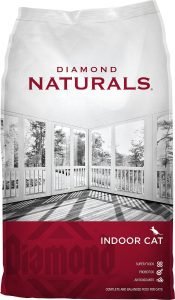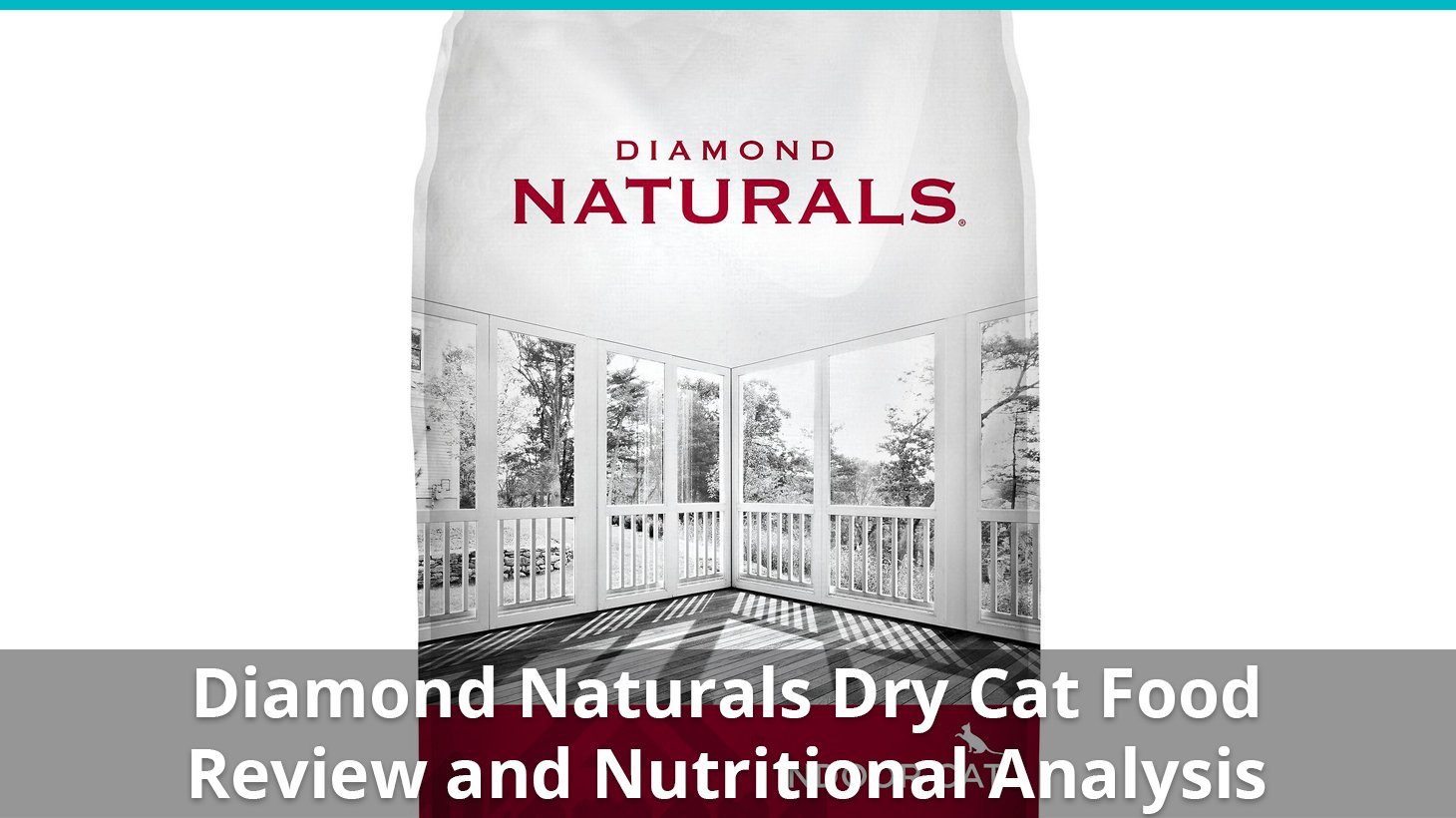Our review process is unbiased and based on extensive research. If you buy through the links on our site, we may earn a commission.
Rating
- Meat is the first ingredient – 1 Star
- Uses some unnamed meats – 1 Star
- Above average protein content – 0 Star
- Less than 4 controversial ingredients – 0.5 Star
- Catological Discretionary Rating – 0 Star
Here’s a few important points to consider for this particular line:
- Meat is the first ingredient
- Most recipes include quite a lot of filler ingredients
- Includes extra vitamins, high quality, proteinate versions of some minerals, and probiotics
- Low protein, high carbohydrate, which is not biologically appropriate for your cat
The Diamond product line includes 5 dry recipes/flavors.
Each recipe below includes its related AAFCO nutrient profile when available on the product’s official webpage or packaging: Growth (G), Maintenance (M), All Life Stages (A), Supplemental (S) or Unspecified (U).
The star rating is a rough average of all of the flavors in a single line of food. If an individual recipe scored lower or higher, we will mark that below, next to the flavor.
- Diamond Naturals Indoor (M)
- Diamond Naturals Active Chicken Meal & Rice (A) 3.5 stars
- Diamond Naturals Kitten Chicken & Rice (A) 3 stars
- Diamond Maintenance (M) 2 stars
- Diamond Care Weight Management (M) 3 stars

Diamond Naturals Indoor was selected to represent the other products in the line for this review.
Diamond Naturals Indoor
Dry Cat Food
| Estimated Nutrient Content |
| Protein | Fat | Carbs | |
|---|---|---|---|
| Guaranteed Analysis | 32% | 14% | NA |
| Dry Matter Basis | 36% | 16% | 37% |
| Calorie Weighted Basis | 32% | 34% | 34% |
Estimated Dry Matter Nutrient Content
Fiber (guaranteed analysis)
8%
Calories/100g
335
Is real, named meat the first ingredient?
Yes
Ingredients
Chicken Meal, Chicken, Peas, Ground White Rice, Cracked Pearled Barley, Powdered Cellulose, Chicken Fat (Preserved With Mixed Tocopherols), Natural Flavor, Flaxseed, Sodium Bisulfate, Choline Chloride, Dl-Methionine, Taurine, Dried Chicory Root, L-Carnitine, Kale, Chia Seed, Pumpkin, Blueberries, Oranges, Quinoa, Dried Kelp, Coconut, Spinach, Carrots, Papaya, Yucca Schidigera Extract, Dried Lactobacillus Plantarum Fermentation Product, Dried Bacillus Subtilis Fermentation Product, Dried Lactobacillus Acidophilus Fermentation Product, Dried Enterococcus Faecium Fermentation Product, Dried Bifidobacterium Animalis Fermentation Product, Zinc Proteinate, Vitamin E Supplement, Niacin, Manganese Proteinate, Copper Proteinate, Zinc Sulfate, Manganese Sulfate, Copper Sulfate, Thiamine Mononitrate (Vitamin B1), Vitamin A Supplement, Biotin, Potassium Iodide, Calcium Pantothenate, Riboflavin (Vitamin B2), Pyridoxine Hydrochloride (Vitamin B6), Vitamin B12 Supplement, Manganous Oxide, Sodium Selenite, Vitamin D Supplement, Folic Acid.
Ingredients in red are controversial or of questionable quality.
Ingredient Breakdown
The first ingredient in this cat food is chicken meal. Good.
Chicken is a very good protein source for cats.
Chicken meal is a concentrated form of chicken, and is considered a high quality ingredient.
In short, much of the moisture of the chicken is taken away, and you are left with a very high-protein, low-moisture powder-like substance.
The inclusion of chicken meal helps to ensure a very high protein level.
The second ingredient is chicken. Good.
While quality of the individual ingredient can vary, chicken is a very good protein source for cats.
It’s also important to note that chicken contains about 70% water, so when it is processed and cooked for use in cat food, it will become a smaller part of the total recipe.
The third ingredient is peas. Bad.
Peas are a quality carbohydrate, but cats don’t need much in the way of carbohydrates.
They are full of fiber, but also contain a fair amount of protein, which we should keep in mind when judging the meat content of this food.
There probably aren’t many peas in here, but there really doesn’t need to be any.
The fourth ingredient is ground white rice. Bad.
It may be slightly better than corn in some areas, but rice is simply not biologically appropriate for cats.
It is a filler ingredient.
Studies hypothesize that rice may decrease taurine absorption in cats, leading to taurine deficiency, a dangerous ailment.
The fifth ingredient is pearled barley. Bad.
While it is a useful grain in most senses, and better than many alternatives, it is still a grain.
And cats do not require grain. Therefore it is not biologically appropriate.
Barley is high in fiber, and has an average amount of protein for a grain.
The sixth ingredient is powdered cellulose. Bad.
A filler high in insoluble fiber. It’s typically wood pulp (sawdust) from pine trees.
Too much insoluble fiber can interfere with digestion and inhibit protein and nutrient uptake.
The seventh ingredient is chicken fat. Good.
Named animal fats in cat food is usually a good thing. Cats do need a fair amount of fat.
Chicken fat is a great source of healthy fats and omega fatty acids.
It is preferred to canola oil or unnamed animal fats.
This recipe includes a number of other ingredients, but once you get down this far, none of them will be in large enough quantities to make a real difference, except for the added vitamins and minerals.
However, there are a few things you should know about.
There are many probiotic strains which help introduce enzymes into the gut to break down the food better and make it more digestible and bioavailable. These are generally considered high quality ingredients.
This recipe utilizes proteinate minerals, which may be easier to digest and more bioavailable for your cat. This is usually a sign of a high quality cat food.
To read a more in depth article about any of the ingredients listed here, check out our Cat Food Ingredient Wiki (currently under development).
The Catological Verdict on Diamond Dry Cat Food
From top to bottom, this is a below average dry product.
Meat is the first ingredient, but there are a lot of filler ingredients.
The protein levels are very low, and the carbohydrate levels are very high. Both of these things point to a low quality food that is nowhere near your cat’s optimal diet.
This is not a good example of a dry food you should be feeding to your cat.
Based on the ingredients and the macronutrient profiles, meat likely plays a moderate part in the recipe, since there are a lot of fillers and a low overall protein count. We can therefore say that it is likely a split meat-and-plant-based cat food, which is not entirely appropriate for your carnivorous feline.
To review, on a dry matter basis, this food is 36% protein, 16% fat, and 37% carbs.
As a group, the brand has an average protein content of 37%, and average fat content of 18%, and an average carb content of 36%.
Compared to the other 2000+ foods in our database, this food has:
- Below average protein.
- Average fat.
- Above average carbs.
Because meat is the first ingredient, but a lot of fillers are used, our average rating for this brand is 2.5 stars.
Not recommended.
Diamond Cat Food Recall History
We do not believe that a recall indicates a low quality food or company, and we respect the fact that sometimes things happen that cause a manufacturer to recall a food.
Usually these things are non-life-threatening, and we think it’s important to take a moment to be thankful about just how few recalls there really are in the industry, considering the enormous volume of food produced.
However, we do believe that a history of recalls may point to a larger issue with a company, and that discerning consumers want to know who they’re buying from, especially when it comes to something as important as the food you feed your beloved cat.
Here is a list of recalls that have affected the Diamond brand in the past:
- March 2013 – Low thiamine levels – 1 recipe affected
- May 2012 – Potential salmonella – Many recipes affected
- April 2012 – Potential salmonella – 1 recipe affected
- December 2005 – Possible aflatoxin contamination – Multiple recipes affected
If you want to stay up to date on the latest recall information affecting your cat’s food, sign up to our email list and receive an email every time a recall is announced. We’ll also let you know about any updated ratings, recipe changes, or new cat foods on the market. (Our alert system will be launched shortly, check back soon.)
Where To Buy Diamond Cat Food
We recommend purchasing your pet products from Chewy.com. They continually prove that they walk the walk while talking the talk, and I’ve never dealt with a more dedicated pet-parent base of people than those who work at Chewy.
Plus, they offer 20% off and free shipping on lots of orders.

